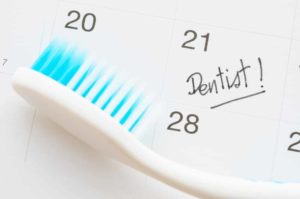
When is the last time you had a dental checkup? Did you know that the American Dental Association (ADA) recommends visiting your dentist twice a year for regular dental checks?
However, patients currently struggling with gum disease or prone to developing cavities may require more frequent dental visits.
Why are dental checkups important?
Your mouth can have any number of the over 600 different bacteria species that have been identified as oral bacteria. Some of these bacteria actually protect you, but others are harmful to your dental and overall health.
The bad bacteria feed on food particles and sugar left behind when you eat and drink. As they feed, multiply, and grow, they produce an invisible sticky film. This film, called plaque, builds up on and between your teeth and along the gum line.
Regular brushing and flossing can remove the plaque, but any plaque not removed hardens (calcifies) into tartar. Also called calculus, tartar is hard and stubborn, and no amount of brushing or flossing will remove it. Tartar removal requires a professional teeth cleaning.
As tartar accumulates, it attracts more plaque and bacteria, and the plaque and tartar spread across and below the gum line. This scenario sets you up for gum problems and tooth decay (cavities).
Dental Checkup Examination
The first part of a dental check involves a thorough dental examination. This includes visual inspection and checking for spaces between your teeth and gums with a special tool.
Your examination may also include dental x-rays so the dentist can see things not visible with the naked eye. This allows for early detection of dental decay, gum disease, and abnormal growths, such as cysts or oral cancers.
Generally, bitewing x-rays are performed once a year, and these focus mostly on your molars and premolars. A “full-set” of x-rays takes a look at all your teeth and the surrounding structures. These are usually taken at your first visit and then every three to five years.
Early detection is critical, as issues caught early are easy to treat, but if they are ignored, serious consequences can occur.
For instance, your dentist can fix a small cavity with a simple filling. However, as it worsens, it may require a root canal and dental crown or even an extraction.
The earliest stage of gum problems, gingivitis, is easy to control, but if ignored, it easily progresses to periodontitis. At this stage, treatment requires deep cleaning and more frequent dental checkups. If not taken care of at this point, it can lead to tooth loss and receding gums with possible gum surgery.
Another problem with advanced gum disease is that oral bacteria can get into your bloodstream through damaged gum tissue. Once in your blood, these bacteria can increase your risk for numerous health issues, such as diabetes, heart disease, and stroke.
During the exam, your dentist will also look for any signs of oral cancer. Many dentists also incorporate a diagnostic tool that can find oral cancer in very early stages.
The Dental Hygienist’s role in dental checkups
Most dentists employ dental hygienists to perform many of your preventive procedures. Dental hygienists receive at least three years of specific dental training and are licensed in the state they practice.
Depending on the state they practice in, a dental hygienist can:
- Perform screenings, such as reviewing health history and assessing oral health
- Take are develop dental x-rays
- Professionally clean your teeth to remove tartar and plaque
- Polish your teeth to brighten them
- Apply preventive materials, such as sealants and fluoride treatments
- Provide patient education, including proper brushing and flossing, nutrition counseling, and explaining any issues or health problems found
The Dentist
During your exam, the hygienist will inform the dentist of your dental exam, and the dentist will come to see you. The dentist will also assess your teeth and gums and look at any x-rays taken.
If all is well in your mouth, that may be all you see of the dentist. If, however, issues are detected, the dentist will discuss a treatment plan to include any needed dental work.
When was the last time you had a dental checkup?
Do you want to prevent ongoing oral health threats that could leave you suffering from discomfort and pain? Would you like to enjoy a healthy and beautiful smile for years to come? If so, regular preventive dental care is absolutely essential.
You should also see your dentist if you have had dental trauma or are experiencing any symptoms of dental disease. Symptoms to watch out for include discomfort or pain, bleeding, heightened sensitivity, or discolored gums or teeth.
Also, it is always best to seek restorative treatment as early as possible. The longer you wait, the more extensive and expensive the treatment will get.
If it’s been longer than six months since you have seen the dentist, or if you have dental symptoms, it’s time to see the dentist.
Call us today
If you are in the Chicago area, Dr. James Fondriest and his caring team would love to serve you. They utilize the latest dental technology and can take care of your preventive and restorative needs. And for those interested, they offer innovative cosmetic dentistry treatment as well.
If you would like to schedule an appointment for a dental checkup or have any questions, call Lake Forest Dental Arts at (847) 234-0517 today.
